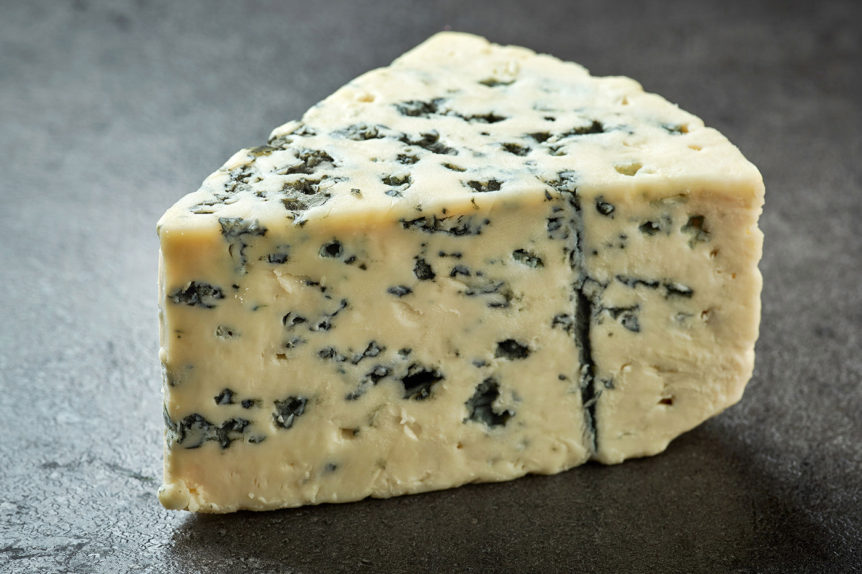At Winding Road Artisan Cheese in Smoky Lake, Alberta, we make all of our cheeses using Thistlezyme®, a true vegetarian, non-GMO, botanical rennet from the flower of the thistle. One of our newest cheeses is Blue Moraine, a “Danish Blue” style cheese with richer umami flavors and notes of mushroom and bacon (without containing any meat).
Ingredients:
150 liters milk
3.0 g MA4001/4002
1.5 g P. Roqueforti (or a strain of your choice)
15 ml Calcium Chloride in ½ cup non-chlorinated water
90 ml Thistlezyme®
Salt – 2% by weight and enough to dry salt later.
- Begin warming the milk with the Calcium Chloride in the Vat. Once the milk reaches a temperature of 10°C/50°F, remove one liter of milk, and use it to rehydrate the cultures and mold used in the formulation.
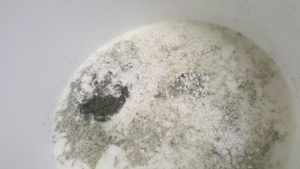
Hydrating the cultures
- Once the temperature of the milk reaches 15°C/59°F, add the rehydrated cultures back to the Vat.
- Continue heating until the milk reaches 32°C/90°F, and add the Thistlezyme®. Mix thoroughly, and then cover. Let your vat sit for 3 hours before checking for a clean break.
- Cut the curds into ½ inch pieces, and allow them to rest for 10 to 15 minutes.
- Give the curds a gentle stir and allow to rest again. Over the course of the next hour, stir the curds once every 20 minutes while maintaining the temperature. This will allow the curds to increase their firmness and their acidity. The curd should be slightly softer than that of a semi-firm cheese.
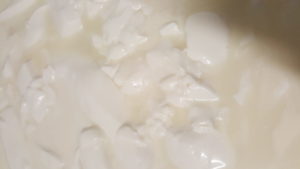
Curds while stirring
- Allow the curds to settle at the bottom of the Vat, then drain all of the whey off of the Vat. Let the curds drain on their own for 5 to 10 minutes.
- Once the curds are fully drained, add 2% salt based on the approximate weight of the curds. Mix thoroughly.
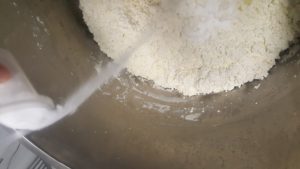
Adding salt
- Once the salt is fully mixed in, allow the curds to drain for five more minutes before hooping them into the molds. We use Saint Paulin molds, and we fill the curds to the top of the molds without pressing them. By not pressing them, we will end up with the nooks and crannies we were looking for in the blue cheese.
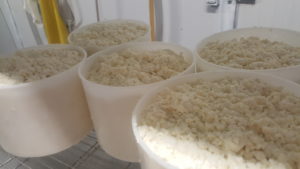
Curds in the molds
- Allow the curds to drain in the molds at room temperature for three days. Flip them every day.
- After 3 days, un-mold the cheese and apply a thin layer of salt over the entire surface of the cheese. Leave the cheese at room temp for two more days; apply another layer of salt each day.
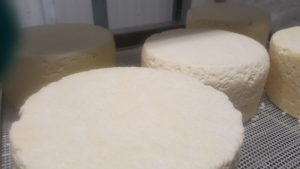
Curds after hand salting
- After the third salt application, move the cheese to an aging room with a temperature of 13°C/55°F and 90 % RH. Age for 10 days, turning the cheese every day.
- After 10 days of aging, take a sanitized skewer and pierce four holes for every square inch on the surface of the cheese. This will allow oxygen into the cheese, promoting the formation of blue veining throughout the cheese.
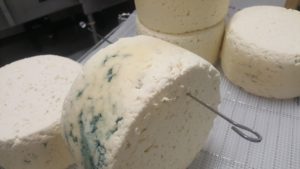
Hand piercing the cheese
- Return the cheese to the aging room, and age until you are happy with the level of blue veining. You can check the veining by using a trier/cheese iron.
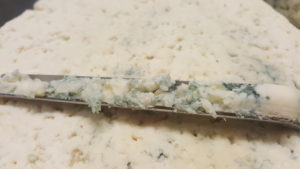
The texture is crumbly but the veining is perfect
- Once you are happy with the veining, you can either wrap the wheels in foil and move them to a cold room (3°C/17°F) to age for a few months to obtain a stronger flavor, or you can release at that time for a milder, saltier, more lactic acid blue cheese flavor.
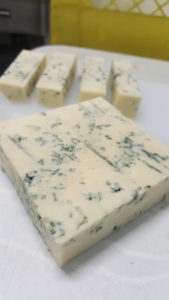
Young blue, mild, salty, lactic
At Winding Road, we like to age this cheese for a minimum of six weeks in the aging room. After two to three months, we find that Blue Moraine develops a nice umami flavor with strong notes of mushrooms and bacon. Our cheese will also have the traditional floral notes indicative of cheese made with Thistlezyme®. Cheese made with Thistlezyme® is unique compared to other blue cheeses because the blue flavor is throughout the paste of the cheese, whereas a traditional blue cheese would have it primarily around the veining of the cheese.
Thistlezyme® is a truly versatile tool for cheese making that Winding Road Artisan Cheese has used to its full benefits. With it, we have made other style of blue cheese such as “Stilton” style, Cambozola, and lactic blue cheese. For more information, be sure to contact us or stop by our booth at the 2019 Cheese Industry Conference in Madison, Wisconsin April 17-18, 2019.

